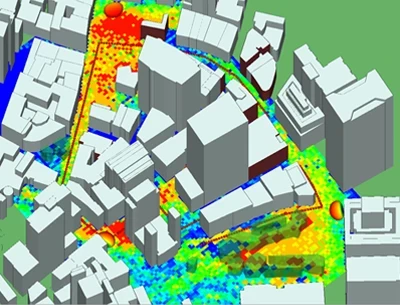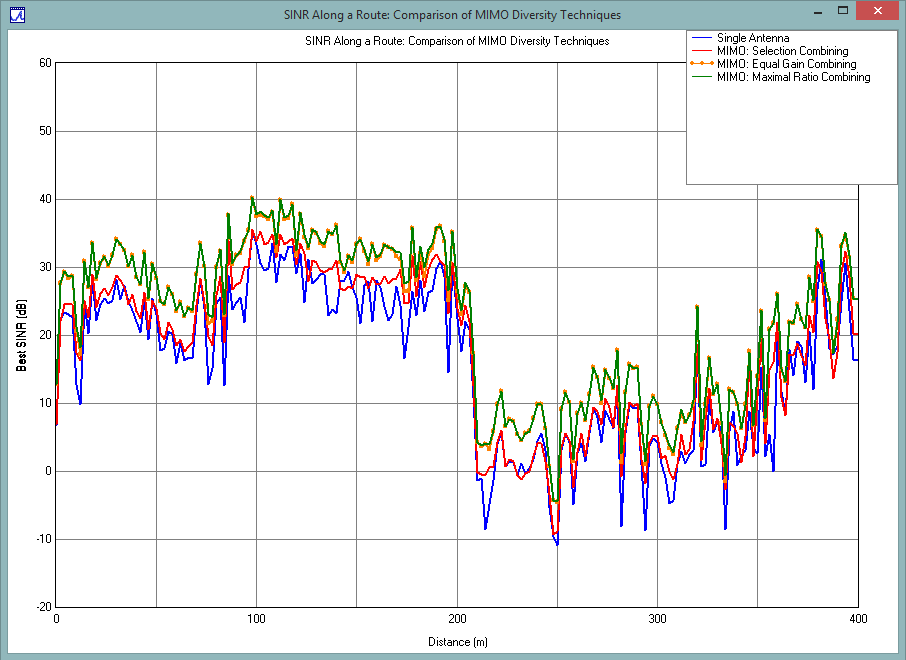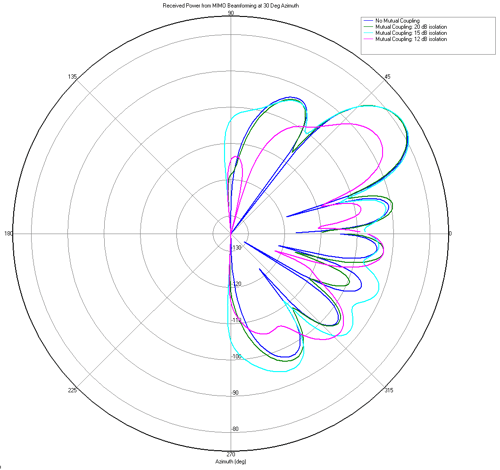- Products & Solutions
- Wireless InSite
- MIMO Beamforming & Spatial Multiplexing
MIMO Beamforming, Spatial Multiplexing and Diversity in Wireless InSite
Wireless InSite provides features to model the following common MIMO techniques.

Antenna Diversity
At a receiver, antenna diversity methods provide a more robust signal with less fading by taking advantage of differences in the signal received by antennas spaced half a wavelength or more apart from each other. Wireless InSite supports three approaches for receiver diversity:
-
Selection Combining: choose signal from receive antenna with strongest SNR
-
Equal Gain Combining: align phases from each receive antenna to sum constructively
-
Maximum Ratio Combining: apply weights to align phases and adjust magnitudes to optimally combine voltage from each receive antenna
When both transmit and receiver diversity techniques are enabled, Wireless InSite will use these together to combine the signals, resulting in overall improved reception for a single stream of data between the transmitter and each receiver point.

Comparison of SINR using different MIMO receiver diversity techniques with 4 Rx antennas. Selection combining (red) reduces fading and moderately improves SINR, while equal gain combining (orange) and maximal ratio combining (green) both increase SINR by several dB.
Spatial Multiplexing
Wireless InSite models spatial multiplexing using Singular Value Decomposition (SVD). Spatial multiplexing takes advantage of the differences in the channels between transmitting and receiving antenna pairs to provide multiple independent streams between the transmitting and receiving antennas, increasing throughput by sending data over parallel streams. SVD decomposes the channel into multiple streams, where the number is the smaller of the number of transmitting or receiving antennas. For scenarios such as 2x2 or 4x2 MIMO, for example, SVD can generate two independent streams, while for 4x4 (four transmit antennas and four receive antennas), it can generate four streams, potentially quadrupling the throughput.
In practice, the actual throughput will depend on how high of an SINR can be achieved in each of the streams. Using the SVD technique, Wireless InSite generates orthogonal data streams and computes the effective SINR for each, allowing it to predict the throughput for each parallel stream. Users can choose between uniform power allocation or waterfilling to improve how power is applied to streams and can request that the model drop poorly performing streams to achieve the combination of power-splitting and streams that provide the best overall throughput. Total throughput from a channel is then calculated from the sum of throughput from all parallel streams.
Massive MIMO Beamforming
The objective of beamforming is to use multiple antennas to form beams, increasing the SINR, and thereby the throughput, to a receiver. Wireless InSite currently supports two methods for beamforming:
-
Maximum Ratio Transmission (MRT): maximizes the beam (adaptively) between Tx and Rx points
-
Precoding Tables: allows a user to define tabulated beams, supporting a number of approaches (codebooks, etc.) that allow for selection from predefined beams
MRT uses information about the channel between the transmitter and receiver antennas to form an optimum beam to the receiver. In practice, this technique would typically be used for a time-division-duplexing (TDD) system, in which the uplink and downlink share the same band, allowing the receiver to send a pilot signal that can be used by the base stations to adaptively form this optimum beam.
Wireless InSite’s precoding tables are more general purpose in nature. A user can define multiple sets of predefined beamforming weights, and Wireless InSite will evaluate the different weightings and choose the strongest beam to each receiver point. This simulates a MIMO base station that has predefined beams (e.g., codebooks), and uses one of a variety of methods to determine the best to use for a given channel.
%2Band%2BMIMO%2BMRT.png)
Massive MIMO beamforming (right) shows significant improvement to throughput over sector horns (left)
Using S-Parameters to Model Mutual Coupling
Many of the MIMO techniques rely on multipath and the spatial separation between antennas to ensure that the many channels between transmitting and receiving antenna element pairs are “orthogonal” or uncorrelated. In real-world systems, however, mutual coupling between the antennas causes the channels to become more correlated, degrading performance of MIMO spatial multiplexing. Mutual coupling can also impact beamforming if weights are not tuned to compensate for it, as shown in the figure to the right. Wireless InSite is able to capture this effect by importing S-parameters, which can be either measured or simulated in a full-wave antenna simulation. During the MIMO post-processing for diversity, spatial multiplexing, or beamforming, these S-parameters are applied to incorporate the effects of mutual coupling, providing an estimate of the degradation that this coupling causes to the calculated results for the MIMO communication system.

Example showing how mutual coupling can degrade MIMO beamforming if sufficiently strong and not compensated for in codebook weighting coefficients.
Save time and reduce costs.
Contact Remcom today for a customized solution to your most complex electromagnetic challenges.
Request a Quote